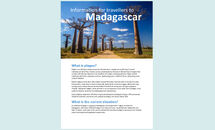Information for travellers to Madagascar
This information leaflet is for general informative purposes only. It can be used in its current form or further modified and adapted by responsible authorities in each country as a country-specific guidance.
Download

What is plague?
Plague is an infectious disease caused by Yersinia pestis, a bacterium usually found in small mammals and their fleas. Humans can be infected by the bite of infected fleas, through direct contact with infected materials or by inhalation of droplets containing bacteria. Plague initially manifests with flu-like symptoms and then rapidly progresses in different forms, depending on the route of infection.
Bubonic plague causes fever with swollen and painful lymph nodes but with no human-to-human transmission, unless there is direct contact with bodily fluids. Pneumonic plague affects the lungs, causing severe disease that can be transmitted directly from sick persons through respiratory droplets. Septicaemic plague, either primary or as a consequence of any other form of plague, is the systemic infection caused by circulating bacteria in bloodstream.
Early antibiotic treatment is effective in both preventing and treating the disease. Without prompt antibiotic treatment, pneumonic and septicaemic plagues are almost always fatal.
What is the current situation?
An outbreak of plague is ongoing in Madagascar since August 2017. Plague is endemic in Madagascar, with cases of bubonic plague occurring every year, mostly between September and April. However, most cases in the current outbreak are pneumonic plague in previously non-endemic areas, including densely populated coastal cities.
Advice for travellers
Before departure
Before travel to Madagascar, depending on destination and type of travel, your healthcare provider may consider prescribing an antibiotic that you would take in case of exposure after medical advice. Additionally, Madagascar is endemic for malaria and the World Health Organization (WHO) recommends antimalarial prophylaxis for travellers.
Prevention measures after arrival in an affected area
- Practice good hand hygiene (e.g. handwashing, use of soap or alcohol solutions).
- Use insect repellents (e.g. DEET 50%, picaridine, IR3535) to avoid flea bites.
- Avoid contact with rodents, sick or dead animals.
- Avoid close contact with persons that may be sick with plague.
- Avoid crowded areas in settings where cases of pneumonic plague have been reported.
Prophylaxis after possible exposure
After close contact with a person suffering from plague or other high risk exposures (e.g. flea bite or contact with bodily fluids of infected animals), you should immediately seek medical advice (including advice on antibiotic prophylaxis and monitoring of symptoms).
Be alert for symptoms
During or the week following travel, you should immediately seek medical advice and inform healthcare providers of your travel history if you have:
- sudden onset of fever with chills
- swollen and painful lymph nodes
- respiratory symptoms like cough, blood-tinged sputum and shortness of breath
- vomiting and nausea
- rapid deterioration of general condition.
Resources
- European Centre for Disease Prevention and Control. Plague outbreak, Madagascar, 2017 –9 October 2017. Stockholm: ECDC; 2017. Available from: https://ecdc.europa.eu/en/plague, https://ecdc.europa.eu/en/publications-data/rapid-risk-assessment-outbreak-plague-madagascar-2017
- World Health Organization. Information for Travellers – Plague, Madagascar [Internet]. Geneva: WHO; 2017.
- World Health Organization. Plague outbreak Madagascar – external situation report 03. Geneva: WHO; 2017.
- France Diplomatie. Madagascar [Internet]. Antananarivo: Ambassade de France à Madagascar; 2017. Available from: https://www.diplomatie.gouv.fr/fr/conseils-aux-voyageurs/conseils-par-pays/madagascar/#sante
- Centers for Disease Control and Prevention. Plague in Madagascar [Internet]. Atlanta: CDC; 2017. Available from: https://wwwnc.cdc.gov/travel/notices/alert/plague-madagascar
Disclaimer: This information leaflet is for general informative purposes only. It can be used in its current form or further modified and adapted by responsible authorities in each country as a country-specific guidance.




